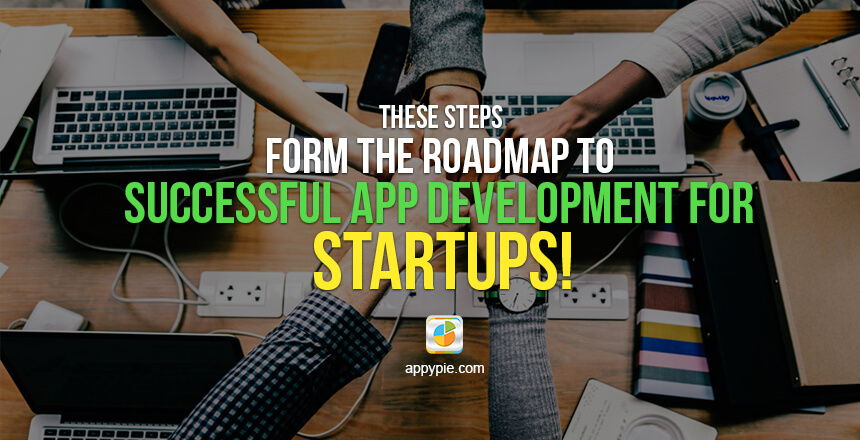These Steps Form the Roadmap to Successful App Development for Startups!

Startups are inherently different from the established brands. In context of an established brand there rarely are many limitations in terms of resources and have a lower go-to market time, while focusing on the quality of the app they release. Startups in general are looking at faster time to market and still get the best quality possible at the lowest possible price possible.
Another important thing to keep in mind is that, not only are the startups always on a shoestring budget, but they are also looking to make money from the app that they are launching. Since the underlying ideas are so different from each other, the journey taken by the two would also differ substantially.
In the post that follows, you would find the perfect roadmap that you can take as a startup to build your own mobile app.
1. Understanding the Customer’s Problem Area
No matter what your business may be, if you are building an app, it is eventually going to be used by the customers you are targeting. It is only logical that if you do not have a clue about the underlying problem, you can’t possibly come up with a design solution for it!
It is therefore important that you identify the real problem areas of the customers. Once you have done that, you can then go ahead and start working on coming up with a solution to take care of this pain. This is what can set you miles ahead of all your competitors.
There are literally millions of apps that you are competing with today. If you can relate to the target customers and understand the problems that they are facing, you would be better equipped to come up with a solution that would address these problems and offer a realistic and appropriate solution.
Either telemedicine app development solution or even a sports-themed app, when you do this right, you would have a clear goal and mission for your mobile app. When you do this right, you would have a clear goal and mission for your mobile app.
2. Conduct Thorough Market Research
A robust market study is crucial, and it is imperative that you validate your app idea in a real-world scenario. This is one of those steps that you simply cannot skip on! In order to conduct your own market research, you can do the following:
- Use Google Trends to figure out whether the search terms related to your app idea are going up or down
- Roll out a survey with some questions revolving around your app idea so that you get a clear idea of the targeted prospective users
- Invest in competitor analysis and gauge out the size and scale of the industry you are going to compete in.
3. Finalize a Great New App Idea
After completing a thorough market research and deep analysis of the market you would be equipped to come up with an awesome app idea. It is of great importance to understand in entirety, the value proposition of the mobile app you plan to build and to have a clarity about USPs of the app. Ask yourself the following questions before finalizing your app idea.
- Why would anyone want to use your mobile app?
- What is the primary user flow through the app?
- What is the single most brilliant feature and the MVP of your app?
Not only do you need to be aware of the core feature of your mobile app, but also have a clear understanding of what the customers would do as they use your app. This naturally leads you to the next step in the process which is building an MVP of your mobile app.
4. Build an MVP
You might be way too attached to the idea of rolling out a near perfect version of your app idea that is loaded with features and offers the best possible experience to your users. Listen to me when I say that it is an unhealthy attachment. It is a better idea to develop an MVP before going full steam ahead in building the perfect version.

The best of the apps available today might not have looked this great when they were first launched. They too underwent a great number of changes before they reached this version. The MVP is essentially a version of the app that only has the core features in it, thus addressing the core problems of the customers.
An MVP is essentially the basic version of the actual product that has only the basic functionality.
When it actually comes to planning and developing a strong MVP for your app, it might be tougher than you think. As you plan to build your MVP, you would have to make sure that not only does it work but can also serve as a suitable test for the final goal they have set for the product.
We have compiled a list of ten best practices that are solid gold when you are on the way to building your MVP.
- Define A Goal
- Be Clear About Your Functional Requirements
- Be Far-sighted
- Have A Clear Business Plan
- Tweak & Adjust
When you set out on your journey to develop your MVP, you should know clearly what your app is supposed to accomplish and how is it supposed to accomplish it. In addition to this, you must also be aware clearly of who is it that you are targeting as the customer base or the audience for the app.
The idea of the MVP is that you should keep everything minimalistic, and this exactly why it is of extreme importance to know what it is exactly that you absolutely must include in order to meet the customer’s needs. Doing this might be really profitable because it could give you an insight into the future prospects of the app.
When you are in the process of developing an MVP for any market or any industry, it is important that you consider the market as a living breathing creature that evolves perpetually. It is good to be aware of the current market scenario and design something for the current market environment. However, in keeping up with the current market conditions it is not wise to overlook the medium and long-term trends.
Let’s say you have a great app and offering your services for free and the app gains a great deal of popularity. Now that you have gotten off the ground, you are thinking about introducing a revenue generation model, but the catch here is – who is going to want to pay for it now?
It is a fact that getting people to suddenly start paying for something that they were getting for free is really tough. And, it is for this reason that you must have a clear business plan for your app, right from the start!
Though it is true that most of the prospects or customers would understand that there would be hiccups in any new app, but this patience would quickly wear out! So, it is important that you put a suitably efficient system in place that can allows you to tweak the app and make needed adjustments.
5. Define a Strong App Strategy
Creating an app in a rushed manner without a strong app strategy can lead you to create a less than perfect final product. The basic architecture of the app is critical and deserves ample attention. An app strategy can only be considered of any value if you have a well thought out business plan at the core of it. The following aspects should be considered while formulating your strategy.
- Set smart goals and devise strong plans for the future of your app and business
- Make an effort to understand the technology that would serve your app the best and choose well
- Plan the budget and resources that you need for the project. It is impossible to have accurate numbers, but it is important that you have an estimate in front of you
- Come up with a realistic marketing strategy and evaluate the rewards. Figure out if the functionality of your app and the chosen monetization model are relevant to the potential users
6. Build a Wireframe
Once you have managed to establish that your app has chances of being accepted fairly well by the audiences, you should then move on to creating wireframe for your app.
When you create a wireframe for your app, you would develop a clear idea of what the app is going to look like and how it is going to work. You also develop a visual clarity of various elements and their placements, whether it is a button or a social sharing widget. You would be able to clearly understand how the users are going to navigate through your app. It can also help you weed out all the bugs that might cause a problem. Most importantly this is the stage when you can figure out whether there is a need to include additional features in the interest of ensuring best usability for your app.
7. Test the Wireframe
It is now time to go ahead and test the wireframe you built. By testing the wireframe you gain an insight into the usability of the app right in the pre-development stage and can also identify any requirements that you may feel the need to incorporate. Also, by carrying out the testing of your wireframe, you gain an opportunity to identify any loopholes that might exist in the functionality, user-friendliness, or design of the app.
8. Design your App
You can’t afford to add design to your app as a mere afterthought! Make good use of the research that you did till now, and translate the tested wireframe into a generous design of the app. You have the whole picture with comments, reviews, and feedback from the users, which would help you understand what your app must look and feel like in order to appeal to them.
It is only natural that people would respond better to things that are beautiful and this is true even for a mobile app.
However, the design of your mobile app must also focus on the user experience. A good design must be supported by great user experience in order to build an app that would have any value at all with the intended users. This aspect of app development is heavily dependent on the current trends in design and UI/UX as well. It would do you well to keep an eye on them.
9. Monetize your App
Let’s face it, as a startup, ROI is of great importance in every project. Hence, right from the word go, it is important that you put a strong monetization strategy in place. This might be something that an established brand may ignore, but a startup must lay appropriate focus on the monetization strategy and efforts.

Explore different monetization strategies like in-app purchases, paid apps, freemium apps, etc. because not every strategy works for every business. Find the one that is best suited to your business model and industry then tweak it enough to suit your brand.
10. Launch & Market your App
Now that you are almost done with the development part of the app, you must sit down with your marketing team and devise a robust marketing strategy. This is a good time to focus all your marketing efforts on the marketing medium that are most likely to get you a sure result. Some of the low cost (or no cost) ways to promote your app include social media marketing, PR, email marketing, SMS marketing, and App Store Optimization or ASO.
11. Keep a Continuous Eye on App Metrics
Even though you may have created the best possible app, it is important to keep an eye on certain app metrics that tell you how your app is doing. These metrics can be categorized into the following 4 heads.
- User engagement
- Customer satisfaction
- Customer acquisition
- App performance
The metrics will help you quantify user behavior, challenges, friction points, and the aspects of your app that are doing well. Once you have these numbers in front of you, the way ahead becomes a little more defined.
12. Continuous App Engagement and Support
On the basis of the feedback you receive from your app users, it is important to offer ongoing app engagement and regular updates. The following points should be a part of your ongoing strategy for app success.
- Introduction of new features in order to expand the functionality and for further development of the product
- Stress on quality assurance to ensure stability control and to reduce the risk of errors
- Review the business model and keep a continuous eye on competition while analyzing them and making sure that you are updated on every level
This process will not only help you fix any bugs or crashes, but also understand what new features you can work on.
Now that you know the way ahead to developing your own mobile app, I wish you all the best for the endeavor ahead!
Related Articles
- The Internet of Things and the Power of Connectivity (Podcast 106)
- How to Use Facebook Messenger Bots for Business?
- Why Businesses Need to Integrate Salesforce DX Now?
- 5 Ways an App Can Get Your Customers To Buy More
- How to Add LiveChat to a Website in 7 Simple Steps?
- 5 Best Payroll Software for Small Businesses
- Combining Network Requests with Combine and Swift
- 10 Blog Title & Idea Generators for Beginners
- Microsoft Teams: Platform Characteristics, Integrations, & Scope with Appy Pie’s Connect!
- How to Create Funny Zoom Backgrounds?
Most Popular Posts
 Photoshop Alternatives: Top 10 Graphic Design Tools in 2024
Photoshop Alternatives: Top 10 Graphic Design Tools in 2024 By Deepak Kumar | July 25, 2024
 Canva vs Appy Pie Design – Which is Better?
Canva vs Appy Pie Design – Which is Better? By anupam | July 18, 2024
 Canva Alternatives: Top 15 Graphic Design Tools to Replace Canva in 2024
Canva Alternatives: Top 15 Graphic Design Tools to Replace Canva in 2024 By anupam | July 18, 2024
 Canva Review: Key Features, Pros, Cons & Pricing
Canva Review: Key Features, Pros, Cons & Pricing By anupam | July 18, 2024
 8 Best ManyChat Alternatives in 2024
8 Best ManyChat Alternatives in 2024 By Samarpit Nasa | July 12, 2024

